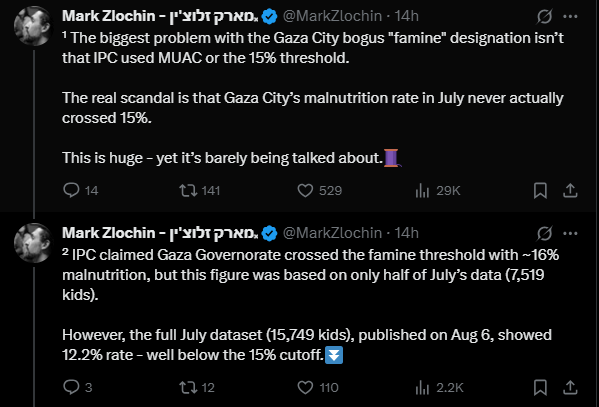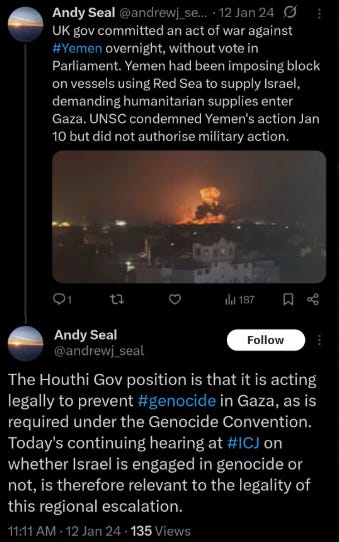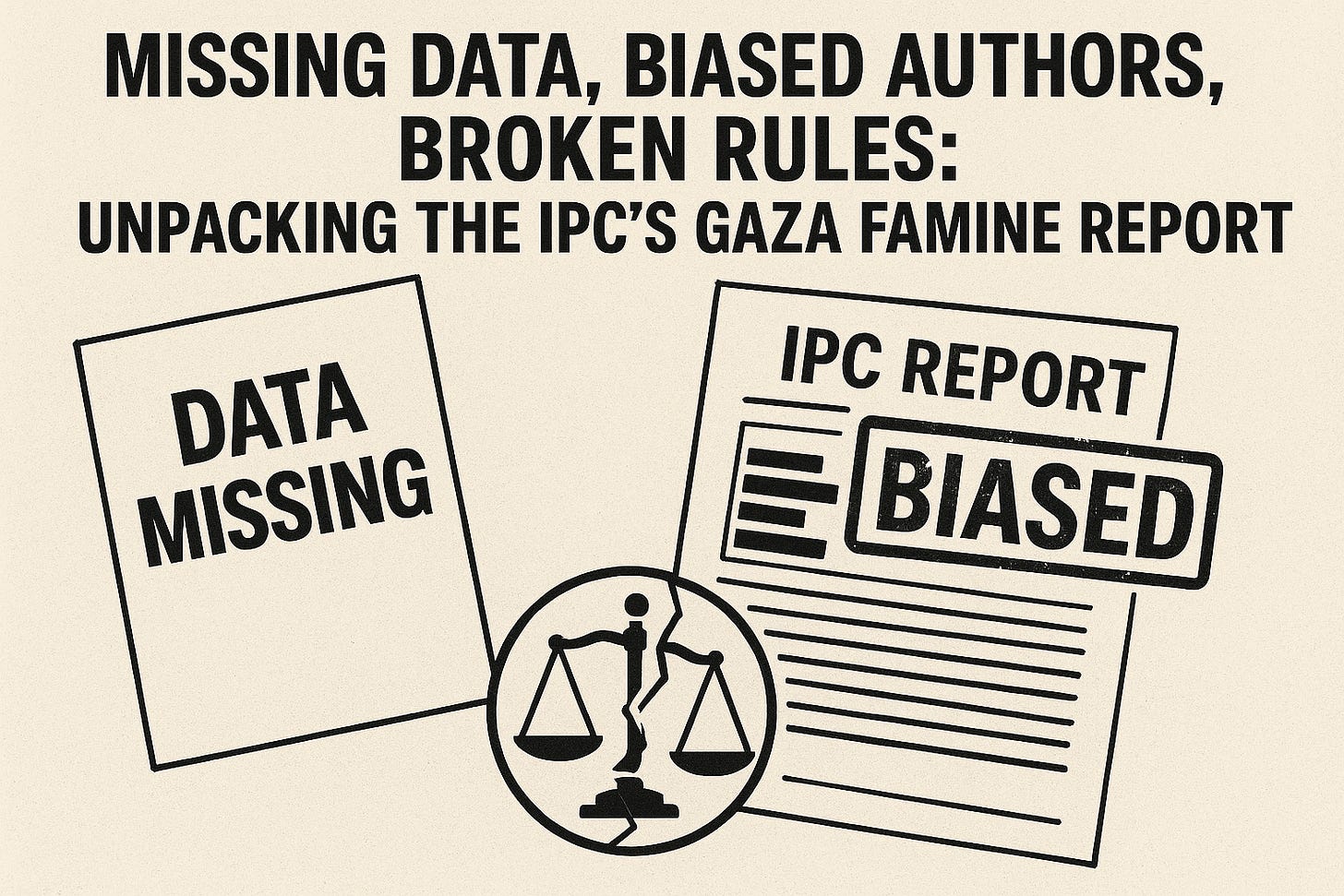Missing Data, Biased Authors, Broken Rules: Unpacking The IPC's Gaza Famine Report
Inconsistent methods, shifting standards, and dubious data sources erode the credibility of what was once seen as the gold standard for assessing global hunger.
The Integrated Food Security Phase Classification (IPC) system's recent declaration of famine in Gaza City has triggered a wave of criticism from experts who argue the report employs inconsistent methodologies, altered standards, and questionable data sources that undermine the credibility of what was once considered the gold standard for global hunger assessment.
Released on Friday, the IPC's latest report marked the first official famine declaration in the Middle East. However, a growing chorus of analysts, researchers, and policy experts contends that the assessment represents a departure from established scientific protocols, raising concerns about the politicization of humanitarian classification systems that guide billions in aid funding and international policy decisions. Various experts have claimed the report contains false, misleading, or manipulated standards, which has enabled the politicization of what should be an objective assessment process.
Data Manipulation Scandal Emerges
One of the most damaging revelation centers on how the IPC handled crucial malnutrition data for Gaza City. Mark Zlochin, a business analyst who has conducted extensive technical analysis of IPC methodologies, uncovered that "Gaza City's malnutrition rate in July never actually crossed 15%" — the threshold the organization used to justify its famine declaration.
According to Zlochin's detailed analysis, the IPC claimed Gaza Governorate crossed the famine threshold with approximately 16% malnutrition, but this figure was based on only half of July's data covering 7,519 children. However, when the complete July dataset of 15,749 children was published on August 6, it revealed a 12.2% malnutrition rate — well below the 15% threshold required for famine classification.
"IPC knew the full July data put Gaza City's malnutrition rate under 15%. Yet they declared famine based on an earlier partial sample - ignoring the complete results that disproved their claim," Zlochin noted. This selective use of incomplete data while ignoring contradictory complete datasets represents what critics characterize as a fundamental violation of scientific methodology.

Systematic Lowering of Evidentiary Standards
The controversy extends beyond data selection to the IPC's modification of core assessment criteria. While the organization didn't formally introduce new indicators, analysts argue it "significantly lowered the evidentiary bar in practice" through its application of existing standards.
Zlochin's technical review reveals that the IPC manual explicitly states the 15% mid-upper arm circumference measurements (MUAC) threshold is "an ad hoc heuristic - not a rigorously defined global threshold" and requires analysts to use historical local data when classifying it. MUAC, which measures the circumference of a child's upper arm as an indicator of nutritional status, is typically used as a quick screening tool in humanitarian settings but is considered less precise than weight-for-height measurements for determining severe malnutrition levels.
In Gaza IPC reports, that fundamental requirement has been consistently ignored," he documented. This omission becomes critical when considering Gaza's unique baseline conditions. Before the conflict, Gaza showed a reversed relationship where MUAC-based measurements yielded 4% malnutrition prevalence compared to 0.8% through weight-for-height measurements - approximately five times higher, not lower as typically observed globally. The IPC's failure to account for this baseline data represents what Zlochin characterizes as a systematic departure from the organization's own methodology requirements.
Authorship Questions Raise Bias Concerns
Additional scrutiny has focused on the report's authorship and potential biases that may have contributed to its conclusion. In another post, Zlochin highlighted that Andrew Seal, a Senior Lecturer at University College London who was one of the experts behind the famine report, already referred to Israel’s war against Hamas as a “genocide” in November 2023.
Expanding on Zlochin’s post, analyst Eitan Fischberger demonstrated that Seal had been characterizing the situation in Gaza as a "genocide" as early as October 28, 2023, and that he had defended Houthi terrorist attacks on shipping by suggesting they were "merely trying to enforce the Genocide Convention." Such pre-existing positions raise questions about whether the report's authors could provide the objective analysis required for credible humanitarian assessment.

The revelation adds to concerns about institutional neutrality when Seal's social media history includes references to "the destruction of the state of Palestine by Jewish insurgents," indicating predetermined positions that may have influenced the technical analysis underlying the famine declaration.
Methodological Issues and Missing Mortality Data
The technical foundation of the famine classification faces additional challenges regarding the IPC's three-pillar requirements. Israeli Ambassador to the United States Yechiel Leiter characterized the campaign as "an orchestrated effort by U.N. agencies promoting Hamas propaganda," pointing to what he described as systematic violations of IPC standards.
The comprehensive Israeli government analysis Leiter referenced documents how the organization abandoned "neutrality safeguards," excluded "critical stakeholders," used data "selectively," and bent "famine thresholds until they no longer matched the IPC manual itself."
Most significantly, the report continues to lack area-representative crude death rate data meeting the required threshold of 2 deaths per 10,000 people daily from non-trauma causes — the critical mortality pillar required for legitimate famine classification. Despite months of dire predictions, this fundamental evidence requirement remains unfulfilled.
Pattern of Unrealized Projections
The credibility issues compound when examining the IPC's track record of failed predictions. Since December 2023, the organization has issued 12 publications warning of imminent famine, with specific predictions including famine by May 2024 and escalating risks following military operations.
However, as documented by HonestReporting, the organization's own Famine Review Committee quietly corrected earlier assessments in June 2024, acknowledging that caloric availability in northern Gaza ranged from 75-109% of needs rather than the previously claimed 59-63%. This dramatic revision received minimal media coverage despite fundamentally undermining months of famine warnings.
The correction revealed that the IPC had initially excluded commercial deliveries, World Food Program distributions to bakeries, and other aid flows from their calculations - omissions that significantly distorted the humanitarian picture and contributed to inaccurate famine risk assessments.
Survey Methodology Compromised by Hamas Influence
A report published by the Center for Medical Integrity reveals additional concerns about the IPC's data collection processes. The organization's survey methodology draws from UNICEF cash aid recipient lists compiled in coordination with Hamas's Ministry of Social Development, creating potential for systematic bias in sample selection.
This dependency becomes particularly problematic when examining cases highlighted in media coverage. The Center's review of 12 prominent malnutrition cases found all had undisclosed metabolic, genetic, and chronic conditions present from birth, suggesting deliberate manipulation of individual cases to support broader narrative goals rather than accurate population-level assessment.
Moreover, the IPC's reliance on hospital screening data rather than community-based surveys violates its own guidelines, which explicitly prohibit health facility data due to its tendency to exclude healthy children and inflate malnutrition prevalence estimates.
Technical Protocol Violations Compound Credibility Crisis
Beyond the data manipulation scandal, the IPC's Gaza assessments violate several established technical protocols that distinguish legitimate humanitarian assessment from advocacy. The organization's use of MUAC measurements while simultaneously lowering thresholds represents what Zlochin identifies as a fundamental misapplication of the methodology.
"Unlike WHZ, MUAC prevalence cannot be used under IPC methodology to distinguish Phase 4 (Emergency) from Phase 5 (Famine), and strictly speaking, the IPC manual defines 15% as the threshold for Phase 4," Zlochin documented. The organization's characterization of this as a "famine threshold" represents a misrepresentation of its own technical standards.
When combined with the selective use of incomplete data, exclusion of contradictory evidence, and reliance on compromised survey methodologies influenced by Hamas, these technical violations create what multiple analysts describe as conditions where classification becomes more about predetermined narrative than evidence-based assessment.




This latest revelation about the IPC’s handling of the Gaza data really highlights the problem: famine isn’t being treated as a scientific classification anymore, it’s being weaponized. Using a partial dataset that showed 16% malnutrition while ignoring the full July numbers (12.2%) is not just sloppy—it’s politicized.
I actually wrote a recent Note on this very issue, pointing out that the amount of food aid entering Gaza has consistently exceeded the needs of its population. That’s why we don’t see the telltale signs of famine across the population, only isolated images of malnourished children used as proof. The IPC lowering thresholds and then cherry-picking data just confirms what many suspected: the famine narrative has more to do with politics than with hunger.
Gaza’s “Famine”: What the Data on Food Aid Really Shows
https://substack.com/@michaelhughsouthon/note/c-149109025?r=5vxvjh&utm_medium=ios&utm_source=notes-share-action
Yes, they only used half of the July data – the second half. Because, obviously, the second half of the month is more recent and therefore more relevant. If the second half of July indicates famine, it doesn’t really matter what the first half suggested.